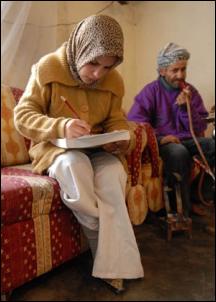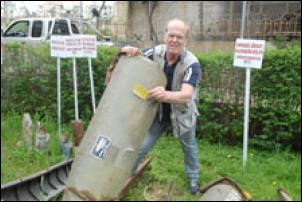Lebanon: De Facto Landmines Continue to Maim
Letter from Lebanon: De Facto Landmines Continue to Maim

Images by Hugh Chatfield
*******
On 5 January, Rasha’s father bought back what seemed to him to be an innocent and curious object. The poor Shia family has no television to follow the news. Unaware of its potential for destruction, Mohammed Zayoun put the leftover from last year’s conflict with Israel into his sack along with the thyme that he had collected. His 4 year old daughter Aya Zayoun found it there and gave it to her big sister. In the explosion that followed, Rasha lost her left leg. Her mother and brother Qassem Zayoun were also struck by the shrapnel.
Around 1 million cluster bomblets remain scattered across Southern Lebanon. The Israeli justification for their use at the time was to cover a wide area to eliminate Hizbullah’s Katyusha attacks against Israel. The United Nations Mine Action Co-ordination Centre in Southern Lebanon (UN-MACC-SL) spokesperson is skeptical about the validity of such claims. ‘We weren’t expecting this,’ says Dalya Farran. ‘Most of the cluster bombs were dropped in the last three days.’
With a high dud rate – roughly 40% in Southern Lebanon according to Farran – remnants remain dangerous. Essentially, argues Kathleen Peratis from Human Rights Watch, ‘Duds become de facto landmines, capable of exploding much later when touched by a plough or a child.’ Handicap International states that 98 percent of cluster bomb victims are civilians.
Established in 2001, UN-MACC-SL coordinated landmine clearance following Israeli withdrawal from Southern Lebanon. Now, teams from around the world must return to areas that had already been cleared of landmines to eliminate cluster bombs ( click here to read about the New Zealand team).
UN-MACC-SL hopes to clear the bomblets from the highest priority areas – residential and agricultural – by the end of the year. Cluster bombs, however, have a tendency to linger long after the conflict is over. Dozens of people still die every year in Laos, to cite but one example, from bombs dropped by the United States during the Indochinese War. A total of 11,000 Laotians have been killed or maimed by these weapons – post-conflict. Since the Vietnam War ended in 1975, there have been an estimated 38,000 cluster bomb victims in Vietnam.

Ironically, some of the cluster bombs dropped by Israel on Southern Lebanon were manufactured in the U.S. during this era. A CBU-58/B cluster bomb lies on the grass amongst the samples collected by the Mine Action Group (MAG) at their base near Nabatieh. It would have dropped 650 BLU-63 submunitions onto Lebanese soil. Some probably exploded, others would have been scattered, waiting to be set off. Most likely by a civilian. Researcher Dr. Franklin Lamb points to a yellow label. ‘Warranty Terminates 2/74,’ it reads. This cluster bomb, used by Israel in August 2006, expired 32 years earlier. Expired weapons have a far higher dud rate.
Yasmine Ryan is a graduate of the University of Auckland, in Political Studies and French language. She is currently interning with a Lebanese newspaper in Beirut, as part of her Masters degree in International Journalism at the Institut d’Etudes Politiques, Aix-en-Provence.
ENDS


 Binoy Kampmark: Fallibility, Dirty Wars And Pope Francis I
Binoy Kampmark: Fallibility, Dirty Wars And Pope Francis I Peter Dunne: Dunne's Weekly - An Issue No-one Can Afford To Lose
Peter Dunne: Dunne's Weekly - An Issue No-one Can Afford To Lose Martin LeFevre - Meditations: Choosing Mass Murder?
Martin LeFevre - Meditations: Choosing Mass Murder? Eugene Doyle: Quiet Mutiny - The U.S. Army Falls Apart
Eugene Doyle: Quiet Mutiny - The U.S. Army Falls Apart Gordon Campbell: Papal Picks, And India As A Defence Ally
Gordon Campbell: Papal Picks, And India As A Defence Ally Binoy Kampmark: The Selling Of America - Ending The US Dollar’s Exorbitant Privilege
Binoy Kampmark: The Selling Of America - Ending The US Dollar’s Exorbitant Privilege